Birding Trip to The Gambia and Senegal – December 4th – 18th, 2021
Konrad Enderlein, Hamburg, Germany
Introduction
After a year and a half into the corona pandemic, it was again possible to plan a long-distance birding tour. After a successful hiking trip in September 2021, I got to work: it should be Africa and an individual trip. I still had two weeks of vacation. The choice soon fell on The Gambia. English is spoken there, the country can be reached relatively quickly and offers a good infrastructure for bird watching. Many Britons visit the former colony in winter for a few warm days and bird watching. The country offers a large selection of knowledgeable guides and appropriate accommodation. It was also appealing to me that I had never been to West Africa.
After studying the various providers, I approach two guides and write both an email in which I introduce myself and my concerns and ask for an offer for a two-week round trip in the first two weeks of December. The answers are there immediately. They are comparable in price, but in the end I choose Gambia Birding Tours led by Karanta Camara because he also integrates trips to Senegal and is available for the entire period. Karanta has 15 years of experience as a guide, he is the president of the Gambia Bird Guide Association and makes a very professional impression both with his website and with personal contact via email. He will only be with me on this tour. This enables me to make a particularly large number of intensive observations and make individual adjustments to the plan on site. Karanta can be reached via www.facebook.com/karanta.camara or www.gambiabirdingtours.com.
At home I use the remaining time to prepare for the expected birds. A list needs to be made and the Field Guide Birds of Western Africa by Nik Borrow and Ron Demey needs to be studied. Due to the 10 trips to Africa that I have done so far, I know many of the 476 species that I put on my Gambia list. A lot of lifers are possible, a total of 85 species. I am very excited. Some species are likely to be quite common, while others are rare or not possible at all. From experience you see about 50-60% of the species on the list, so I'm hoping for 250 species in total and about 40-50 lifers. I am particularly hoping for the Egyptian Plover, the only representative of its genus within the order of Charadriiformes birds. Let the games begin...
December 4, 2021 - Arrival
Despite increasing numbers of corona infections worldwide with the new omicron variant, I decide to embark on the journey. To be on the safe side, I'll do a PCR test on Friday, December 3rd, for the staggering price of 177 euros, although this isn't mandatory for entry or transit. The taxi is ready at 4:45 a.m. and takes me to Hamburg Airport. Despite the long queue at the counter, check-in goes smoothly, so I fly to Brussels at 7:15 a.m. on Brussels Airlines flight SN2630. I stay there for about 3 hours until flight SN203 to Banjul takes off at 12:15 p.m. It is my first flight since February 2020 (Uganda), after that Corona made many trips impossible. The Airbus A350 is three quarters full, but there are hardly any tourists on board. I enjoy the flight over northern Africa, especially the snowy peaks of the Atlas Mountains are very impressive. After a stopover in Dakar, the capital of Senegal, it takes another half hour until we touch down at Banjul International Airport at 7:45 p.m. local time (-1 hour difference to Hamburg). My luggage is there, the immigration procedures (visa: 20 USD) take a while, but there are no problems. Karanta welcomes me in front of the airport building.
December 5, 2021 - Kartong Wetland, Gunjur Community Forest and Tanji Bird Reserve
Text paraAfter a breakfast of toast, omelette and fruit, we set off from Lemon Creek Resort, where Karanta had brought me the night before, at 7:30 a.m. in the direction of Kartong, a wetland area in the very south of the Gambian coast. We keep stopping along the way - there are a lot of birds right next to the road! - In the former sand mining area Kartong Wetland there are some freshwater ponds in the middle of a dry bush savannah. We see Squacco, Western Cattle, Grey, Black-headed, Purple, Great and Black Heron, African Spoonbill, African Swamphen, Black Crake, African Jacana, White-faced Whistling Duck, Northern Pintail, Senegal Thick-knee, African Darter, Reed Cormorant, African Sacred Ibis, Pink-backed Pelican, Common, Green and Wood Sandpiper, Common Greenshank, Mosque Swallow and also birds of prey, including Western Marsh Harrier and Western Osprey. The Northern Carmine Bee-eaters, who are intra-African migratory wintering guests here, are particularly beautiful.
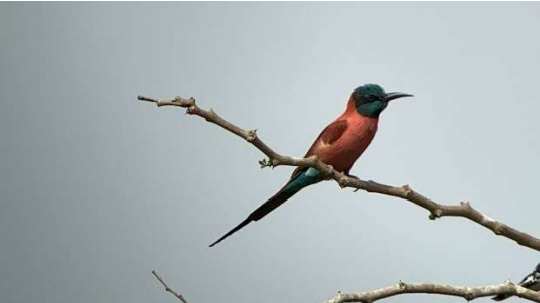
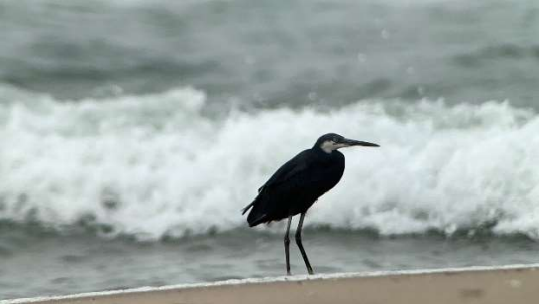
Northern Carmine Bee-eater Western Reef Heron
A piece of the Atlantic coast also belongs to the protected area of Kartong, where we are unsuccessfully looking for the White-fronted Plover, which is rare here. But we see a lot of terns and seagulls, including West African Crested Tern (lifer), as well as a number of Western Reef Herons. After the long hike on the beach, it has become really hot, well over 30 degrees Celsius. We take a break at a shelter where I drink a freshly squeezed grapefruit juice. Another tourist group joins us. There is a lively discussion among the guides about yesterday's presidential election. The result is not yet available, but that is exactly what unsettles everyone.
On the way back from Kartong we stop at the Gunjur Community Forest, where after a short search we find Capuchin Babbler, which is only found here in The Gambia. In Semliki, Uganda, I had only heard this bird in the undergrowth. Now it worked out, but the birds are too quick to take a photo.
After a late lunch we go to Tanji Bird Reserve, a 6 km² sanctuary that includes an area of dunes, savannah, mangroves and lagoons at Cape Bald. It is one of the most important birding areas in The Gambia - more than 260 species have been sighted here. We see Caspian Tern, Purple Roller, Vieillot's and Bearded Barbet, Yellow-billed Shrike, Piapiac, Melodious and Subalpine Warbler, Blacknecked Weaver, Lesser Blue-eared Starling and Western Yellow Wagtail, among others.
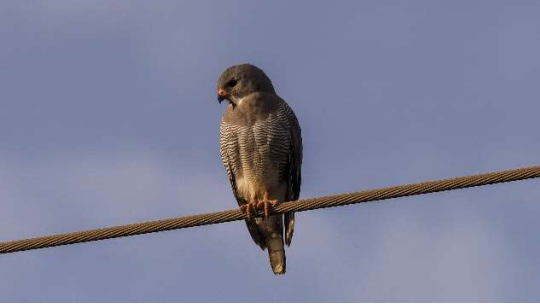
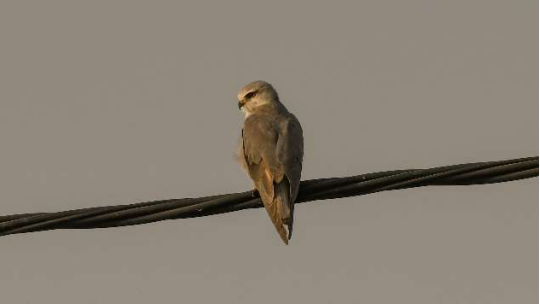
Lizard Buzzard Black-winged Kite
A very successful first day comes to an end with 122 species, including 18 lifers, on my list.
December 6, 2021 - Bonto Forest, Pirang Pools and Farasuto
Due to the unpredictable events surrounding the presidential election, Karanta has changed the originally planned program somewhat. We'll stay in the coastal region today and head upriver tomorrow. Our departure from the lodge is delayed because the staff is 30 minutes late in the breakfast room. I'm the only (!) guest in this large facility - Corona is giving everyone in the tourism industry a hard time.
Today there are several observation points on the program. First, we drive about 45 minutes to Bonto Forest. The target is the White-spotted Flufftail. And the bird is there - I can even take a picture! We also see Green Hylia, Violet Turaco, Brown-necked Parrot, and, as the "icing on the cake", a Verreaux's Eagle-Owl sleeping high up in a tree. I can photograph the owl well using digiscoping. This year I bought a new spotting scope attachment for my iPhone Xs from Kona, which works better now. Otherwise, I have my tried and tested Nikon D500 with a 300mm lens. We have plenty of time for observing and taking photos - that's the advantage when there's only two of you. Karanta is also into photography, he has a Nikon D5500 with a Tamron 150-600mm lens. He mainly uploads his pictures to his Facebook page. He has many ideas to generate more business. I feel already that I made a good choice to go with Karanta.
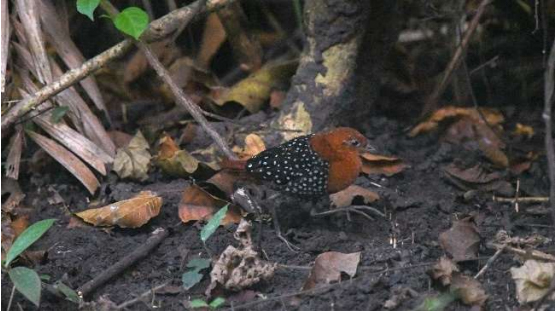
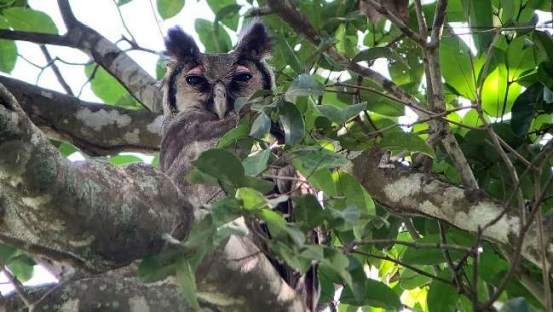
White-spotted Flufftail Verreaux's Eagle-Owl
The former shrimp farming ponds of Pirang are our next destination. The 1 km² area is now a paradise for waterfowl. We see Slender-billed and Lesser Black-backed Gull, Little Tern, Greater Flamingo, Northern Pintail, Pied Avocet, Black-winged Stilt, Bar-tailed and Black-tailed Godwit, Ruff, Grey Plover, Common Redshank, Common, Marsh, Wood and Curlew Sandpiper, among others. In winter, The Gambia is home to a large number of Palaearctic migratory bird species - this also makes this country so attractive for bird watchers.
The next stop is the 3-hectare Farasuto Forest Community Nature Reserve. Established in 2008 by local bird guides, it is home to over 100 species of birds. It is the only place in The Gambia where African Wood Owl can be reliably observed. In addition, the local guides know the resting places of the Standard-winged Nightjar. We manage to see both as well as a pair of Greyish Eagle-Owl.
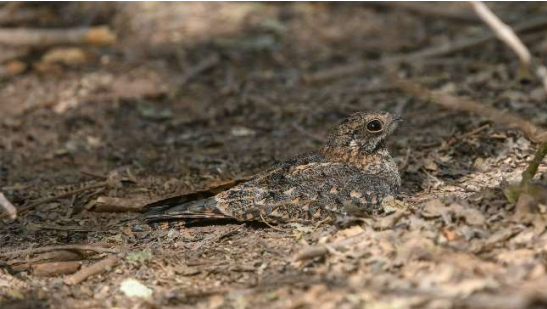.jpg)
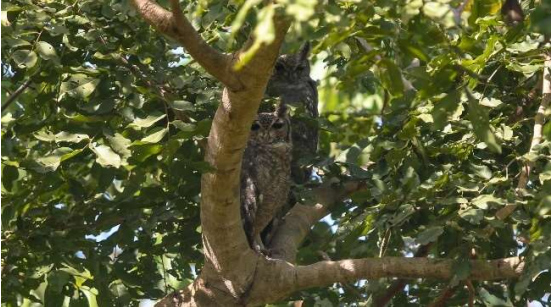
Standard-winged Nightjar (female) Greyish Eagle-Owl
Our last destination for today is Kotu Bridge. The bridge crosses the Kotu Creek just before it flows into the Atlantic Ocean. It is often the first port of call for bird watchers in The Gambia, as many typical species can be observed here in a small area. Here is the information center of the Gambia Bird Guide Association, of which Karanta is the president.
The small area at Kotu Bridge contains mangroves, mudbanks and reeds - more than 70 species are possible on a short walk. After a stroll through the grounds at the Kotu Bridge with sightings of Pearlspotted Owlet, Little Grebe, Broad-billed Roller, Blue-breasted Kingfisher, and Western Bonelli’s Warbler, we stop on the tourist strip to exchange money. The Dalasi to Euro rate is 59.50:1.
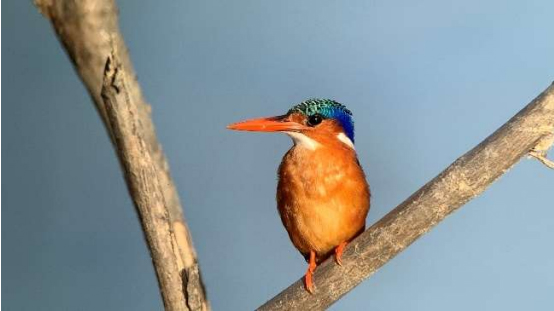
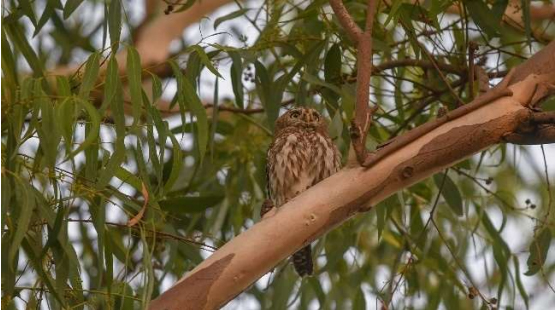
Malachite Kingfisher Pearl-spotted Owlet
Our day was sensationally successful with 128 species, including 7 lifers: Ahanta Spurfowl (heard only), Violet Turaco, Greyish Eagle-Owl, Spotted Honeyguide, Brown-necked Parrot, Red-chested Swallow and West African Swallow.
December 7, 2021 - Driving on the South Bank Road to Morgan Kunda Lodge near Jajari
Today we drive inland along the Gambia River to Upriver Gambia. Karanta proposes to take another guide to help him with the driving. Of course, I'm fine with that. Aziz has never been to Niokolo-Koba National Park in Senegal and he would like to take the opportunity. This does not incur any additional costs for me, on the contrary: Karanta has more time for me and we can go birding in remote areas with peace of mind because Aziz stays in the car and looks after things. He is also a keen guide himself and keeps his eyes open so that I get the chance to see even more birds.
After some shopping in Brikama we leave the densely populated coastal area. The South Bank Road is in very good condition, so that the approx. 200 km are easy to manage. We make several stops along the way. Around Bessi we walk through the bush land and see, among other birds, Senegal Eremomela, Splendid, Scarlet-chested and Beautiful Sunbird, Common Chiffchaff, Northern Yellow White-eye, and Black-faced Firefinch.
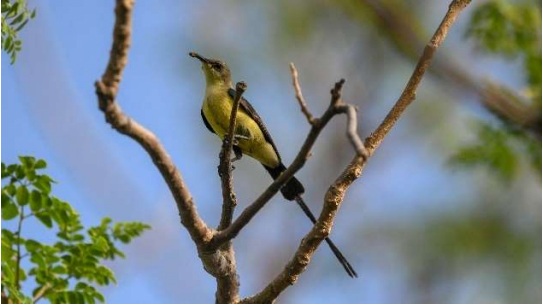
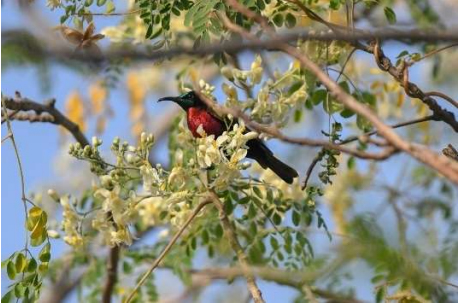
Beautiful Sunbird Scarlet-chested Sunbird
The valley at Kampant is called "Raptors' Cottage" by the guides. We discover Martial Eagle, Bateleur, African Harrier-Hawk, Shikra and White-backed Vulture. Further on, we search intensively for Temminck's Courser on the harvested peanut fields - without success. Instead, there are Black-headed Lapwings. The land along South Bank Road is used for agriculture. In addition to rice, maize and millet, mainly peanuts are produced. Together, Senegal and The Gambia are the largest peanut exporters in the world. There are still a few nuts in the fields - very tasty!
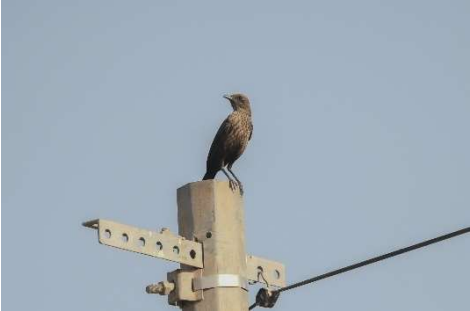

Northern Anteater Chat African Harrier-Hawk
North of Soma we cross the mighty Gambia. The river runs a total length of 1,120 kilometres – it is one of the main streams in West Africa. The Senegambia Bridge, opened in 2019, is the only bridge that connects the two parts of the country north and south of the Gambia. The bridge is very impressive. It's not listed in my 2018 Bradt travel guide so I was already wondering how we'd manage to take the unreliable ferry to the northern part of the country... Since there's no traffic, we can stop at the crest of the bridge and take in the view from a clear height of 20 meters.
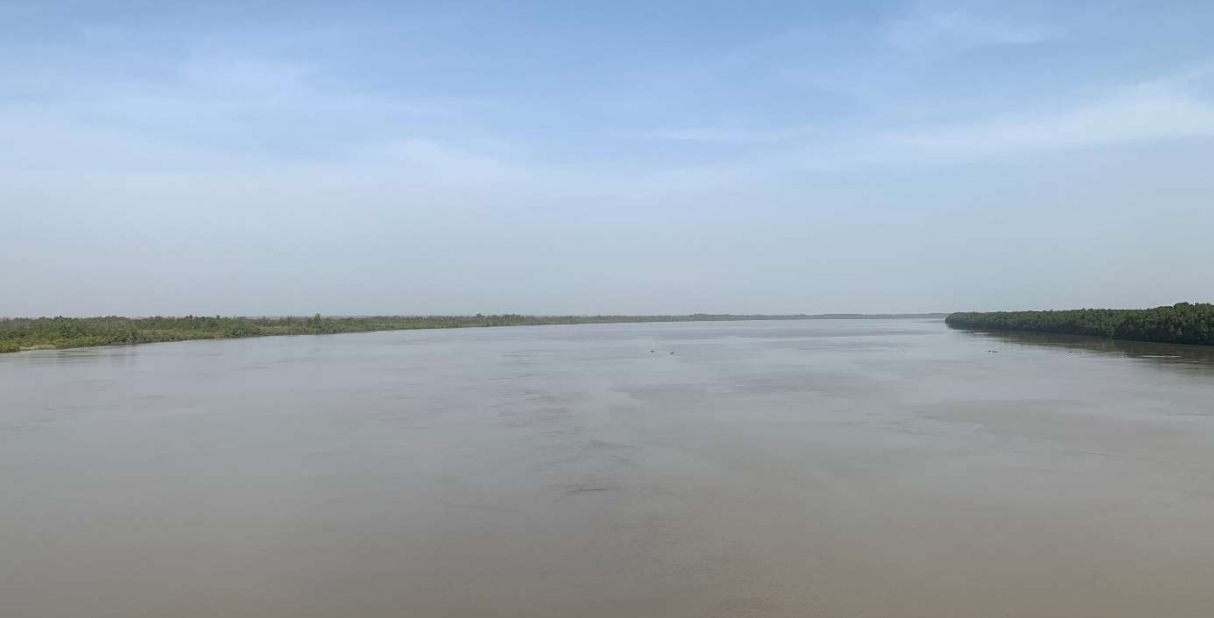
View from the Senegambia Bridge
We stop briefly in the next town of Farafenni, as we are going to Senegal tomorrow and we don't want to waste any time shopping there. As we leave Farafenni we see three birders with their guide and stop. A Northern Anteater Chat is sitting on a building shell. This species has its southern limit of distribution here. I am delighted and take photos. Suddenly there is a lot of screaming. Some residents complain loudly. I should have asked permission, Karanta translates. He doesn't agree at all with the behaviour of the locals and tries to make them understand what we're doing here. It almost comes to a scuffle.
Upon arrival in Jajari, we head straight into the bushland. We see Sahel Paradise Whydah, Tawnyflanked Prinia, Rufous-tailed Scrub Robin, Sahel Bush Sparrow, Eurasian Wryneck, Green Bee-eater, Whistling Cisticola, and Black-crowned Tchagra. Just before sunset a Savile’s Bustard calls but we don't find it.
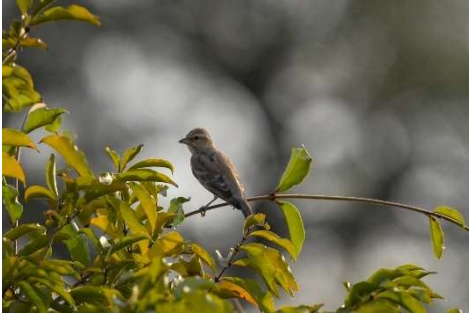
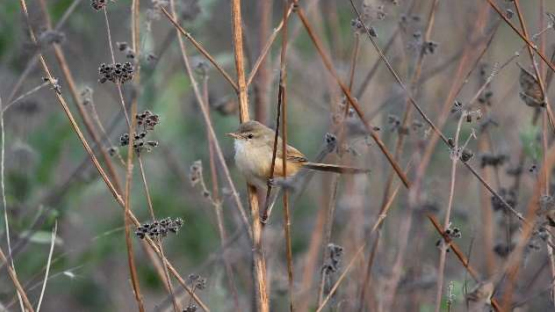
Sahel Bush Sparrow Tawny-flanked Prinia
December 8, 2021 - Kaolack - Forêt de Kousmar (Senegal)
Today we have something special planned: a trip into Senegal to visit the roosting place of Scissortailed Kite. It was one of the reasons why I chose Karanta as my guide as he is one of the few who offer this. The Corona situation makes it a little uncertain, but we'll try. The three Dutch people in the Morgan Kunda Lodge are refraining from visiting Senegal because a PCR test is supposedly required. At the border it is completely different. The officer doesn't even want to see my vaccination certificate. Karanta and Aziz have more paperwork to fill out for the car. After 45 minutes everything is done. The approx. 100 kilometres are quickly covered on the good tar road. At 10:30 a.m. we are in Ndiaffate south of the island of Kousmar where the roosting trees are located. The local guide is there, but the boat to get to the island has drifted away. We cannot visit the island now, only at 5 p.m. So we have to reschedule.
The change of plan means we can now roam the acacia savannah all day long. It gets very hot during the day but it's worth it. Right at the beginning we see Yellow-bellied Eremomela, which is also something special for Karanta. We also find Common Whitethroat, Eurasian Wryneck, Tawny Pipit, Sudan Golden Sparrow (Lifer), a melanistic Montagu's Harrier (!), Beaudouin's Snake Eagle, Northern Wheatear, Blue-naped Mousebird, Chestnut-bellied Starling (Lifer), Chestnut-backed Sparrow-Lark, White-rumped Seedeater (Lifer), White-billed Buffalo Weaver, Woodchat Shrike, Red-necked Falcon and the desired Savile’s Bustard.
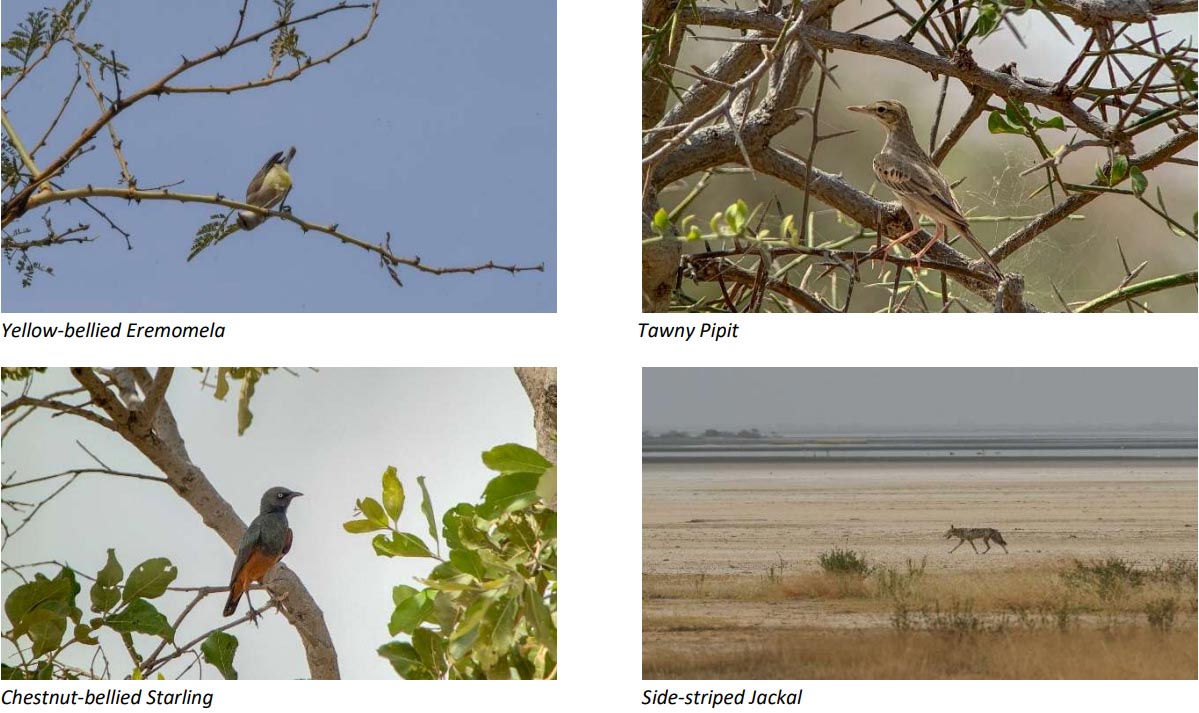
After some back and forth, the boatswain finally arrives at 5 p.m. The anticipation is growing - many birds can be seen through the spotting scope. After leaving the boat, we walk about 400 m barefoot through the mud to the island. Thousands of Scissor-tailed Kites come to roost in the Forêt de Kousmar, on a single baobab tree often more than a hundred birds.

A fantastic day comes to an end. Rarely have I had such a spectacular experience of nature on my travels. The dramaturgy could not have been better: the anticipation already at home, the uncertainty about entering Senegal, the disappointment about the boat being drifted away in the morning, the spontaneous change of plan with the hope of success, the awesome observations during the day (that we wouldn't have had otherwise), the adventurous route to the island and the grande finale with hundreds of Scissor-tailed Kites in front of my eyes!
December 9, 2021 - Drive to Bansang
Due to yesterday's rescheduling, we had spent the night again at the Morgan Kunda Lodge. Today we want to go to Janjanbureh, formerly known as Georgetown. Everything points to a relaxed travel day with many observation stops. After breakfast we start our discoveries about 5 kilometres south of the lodge in the bush savannah at Jajari.
The two-hour walk through the area at Jajari was very productive with Gabar Goshawk, Bruce's Green Pigeon, Speckle-fronted Weaver, Yellow-crowned Gonolek, Rufous-tailed Scrub Robin, Brubru, Vieillot's Barbet, Black Scimitarbill, White-fronted Black Chat, and a distant Temminck's Courser.
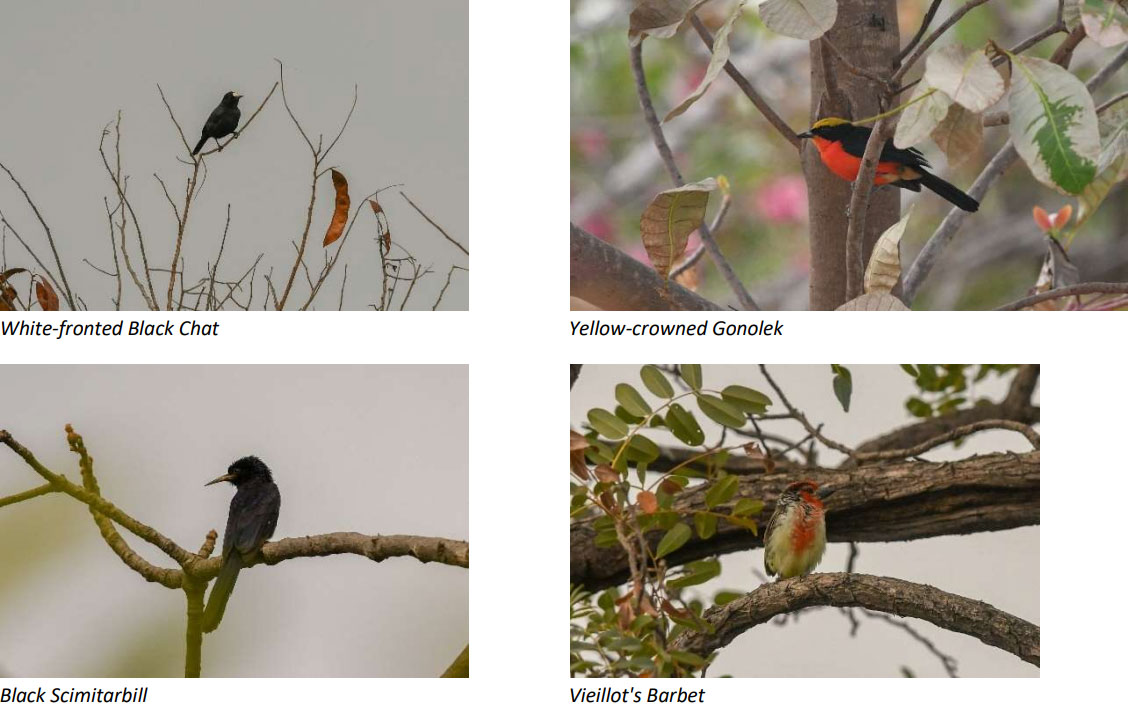
After that we drive to Farafenni to buy water, bread, sardines, corned chicken and a watermelon. We continue east on the North Bank Road. We want to find the Egyptian Plover. This bird is one of the main attractions for birders in The Gambia, I expected to see it when choosing the trip as it is a relatively common bird on sandbanks and river banks in West Africa. At the wetland at Kau-ur we see Collared Pratincole, Ruff, Common Greenshank, and Quailfinch, but no Egyptian Plover. But they are there at a pond near Njau: three Egyptian Plovers. Excellent!
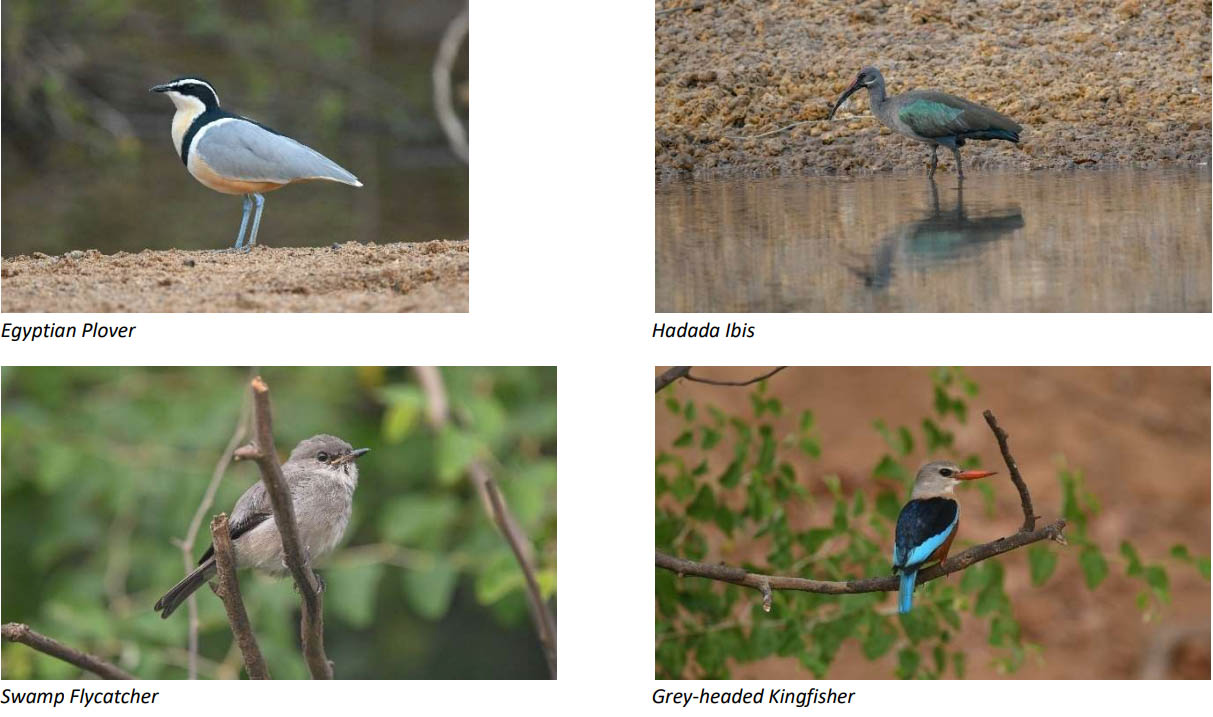
After observing the Egyptian Plover we take our lunch break before continuing to Wassu. The stone circles of Wassu belong with other monuments in Gambia and Senegal to the Senegambian stone circles in a so-called megalithic zone, in which in the 7th to 8th century AD a high culture must have existed in West Africa. The stone circles were probably set up for religious burial rituals. The stone circles usually consist of 10 to 25 stone blocks of worked laterite rock weighing between 2 and 10 tons. Although a tomb is associated with each stone circle, the meaning and purpose of the stones is still an archaeologically unsolved mystery. The Wassu Stone Circles have been a UNESCO World Heritage Site since 2006.

In the Wassu gravel pit, we are delighted by numerous Red-throated Bee-eaters. There are also Sand Martins, Western Cattle Egrets, Red-billed Queleas, Laughing Doves, a Sahel Paradise Whydah and a few African Wattled Lapwings. At a stop at a waterhole on the way we see another lifer for me: Gosling's Bunting.
The ferry to Janjanbureh is broken, so we rearrange again and continue to the next ferry upriver at Bansang. Our accommodation has been rebooked - Karanta is very flexible and prepared for everything. We “only” have to take the ferry across the Gambia. We can already see our hotel on the other side. But we are in Bush Town, as a sign clearly indicates. And that has its reason. I experience a piece of African reality like I have never experienced before. The hand-operated ferry is totally overloaded - a truck gets stuck when going up the ramp. But people remain calm. After two hours we are finally over. We are compensated by a magnificent sunset.
December 10, 2021 - Drive from Bansang to Wassadou (Senegal)
The day starts at 5:40 a.m., again with great colours in the sky. From the terrace of Bintou's Paradise Lodge we have a wonderful view of the river Gambia. Our breakfast of omelette and bread is so early because we are set on a long drive to Senegal. At 7:00 a.m. we start from Bansang and first drive 60 kilometres to Basse Santa Su, the largest city of the Upper River Division, 370 kilometres away from Banjul. It is the last chance to refuel in The Gambia and to buy provisions. Kamara also exchanges money - in Senegal the CFA franc is used (1 € = 656 CFA). Kamara gets 5,000 CFA for 465 Dalasi. At the small border station Sabi we are all alone, so everything goes very quickly. In fact, they want to see my vaccination certificate here.
After the immigration formalities, we drive to Vélingara. There we are stopped by the traffic police. After some back-and-forth, we receive a fine of 3,000 CFA for improper luggage transport, because our suitcases or travel bags are not attached to the roof but are inside. Ridiculous!
On the well-paved national road N6 we go via Manda to Tambacounda, where we turn onto N7 to the southeast. We make good progress and only stop when birds of prey appear. At one point we see White-backed Vulture, Rüppell's Vulture and Griffon Vulture all at once. Great! - I have never observed Griffon Vulture in Africa.
Already at 12:15 p.m. we reach the Campement de Wassadou. It is beautifully situated on the bluffs of the river Gambia, a great place to stay. After noon we see Senegal Batis and Blackcap Babbler while walking through the area. The boat is ready at 5 p.m. The boat ride is fantastic. In addition to many birds like Egyptian Plover (6 individuals), West African endemic Adamawa Turtle Dove (Lifer), Mourning Collared Dove, Hadada Ibis, African Fish Eagle, Woodland, Blue-breasted, Grey-headed and Malachite Kingfisher, Purple and Long-Tailed Glossy Starling, Swamp and Northern Black Flycatcher, we also see hippos and a troop of Guinea Baboons.

After a very good dinner - chicken with rice and flambéed banana for dessert - we review the day. After six days we already have 245 species on the list, many more than I thought. In fact, there are four other guests at the lodge today. That's worth a note in Corona times - how is the tourism industry going to survive?
December 11, 2021 - Niokolo-Koba National Park
Today, we look forward to another highlight of the tour: the Niokolo-Koba National Park. We put up with the long journey to Senegal to track down some species that are rarely found in The Gambia. The national park is located in south-eastern Senegal on the border with Guinea-Conakry at an altitude of 15 to 300 metres above sea level. The park is 9,130 square kilometres in size and has been a UNESCO World Heritage Site since 1981.
The night was quite cool for Africa, I estimate around 12° Celsius. Fog has formed over the river - unfortunately there are no African Finfoots to be seen. Karanta and Aziz are pretty cold. A coffee helps. Our breakfast at 7:30 a.m. is delicious: baguette, honey and jam - it shows that Senegal was once a French colony.
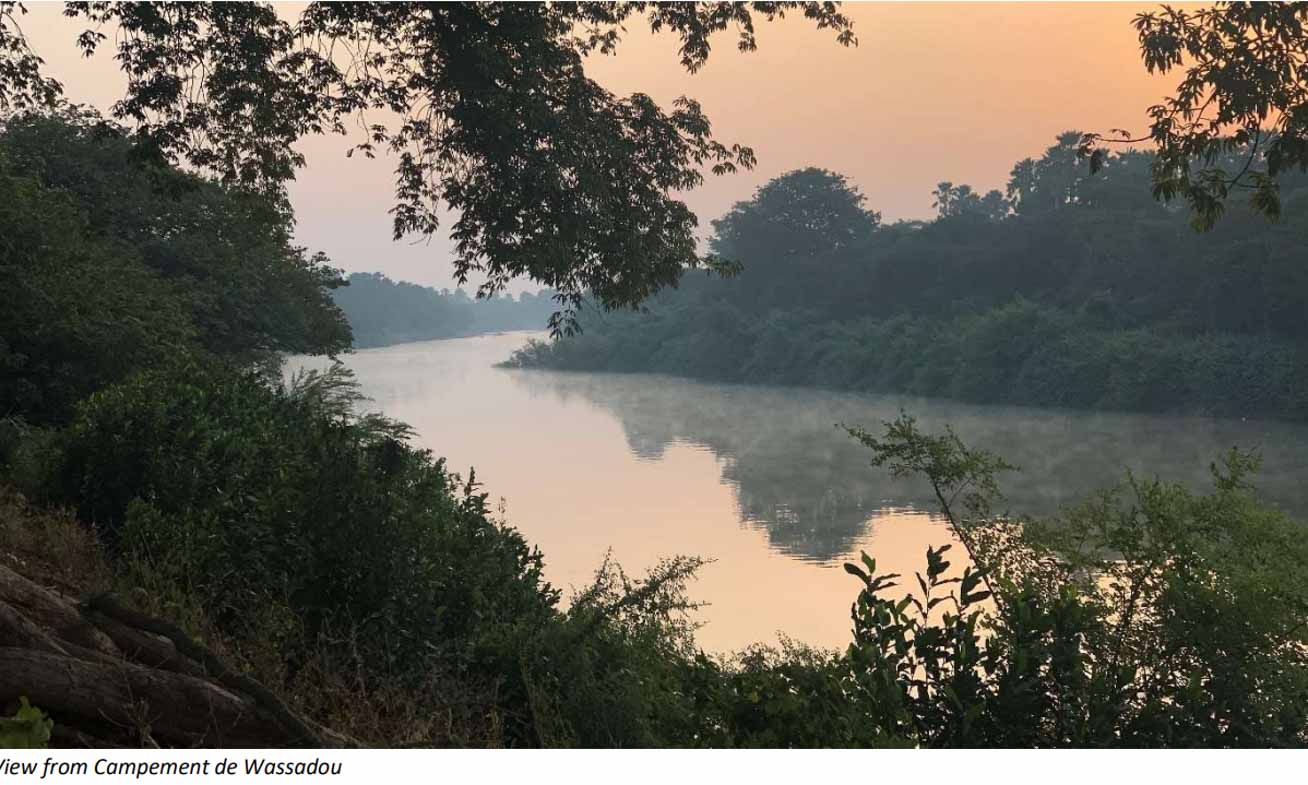
Then we drive the 30 kilometres to the park entrance with our minibus. Yesterday we decided against going with a national park jeep. On the way we see an African Hawk-Eagle. At the entrance of the national park we take Banna into the car as our official guide - it is mandatory to hire a local guide. He will not contribute very much, except for spotting Roan antelope at the end of the day.
The vegetation of the national park consists mainly of bush savannah, to the east the vegetation becomes increasingly drier. Extensive gallery forests line the banks of the river. The number of large mammals has decreased dramatically in recent years due to poaching. There are 84 species of mammals and 330 species of birds in the park. We only make slow progress and see an Oribi, a Common Warthog and a Eurasian Hoopoe right at the beginning - then very little for a long time.
Around noon we reach Camp Sementi after about 40 kilometres of difficult driving. It's very run down, almost deserted. We struggle to get an overpriced beef and spaghetti lunch. Observations are also rather sparse: an African Jacana and at least a few photogenic Red-throated Bee-eaters can be seen in the extensive swamp area. It is rather disappointing. On the game drive we see Doublespurred Spurfowl, Stone Partridge, Abyssinian Roller, Red-shouldered Cuckooshrike, Chestnutcrowned Sparrow-Weaver, several Abyssinian Ground Hornbills, Bateleur, Helmeted Guineafowl, Four-banded Sandgrouse and a Pallid Harrier.
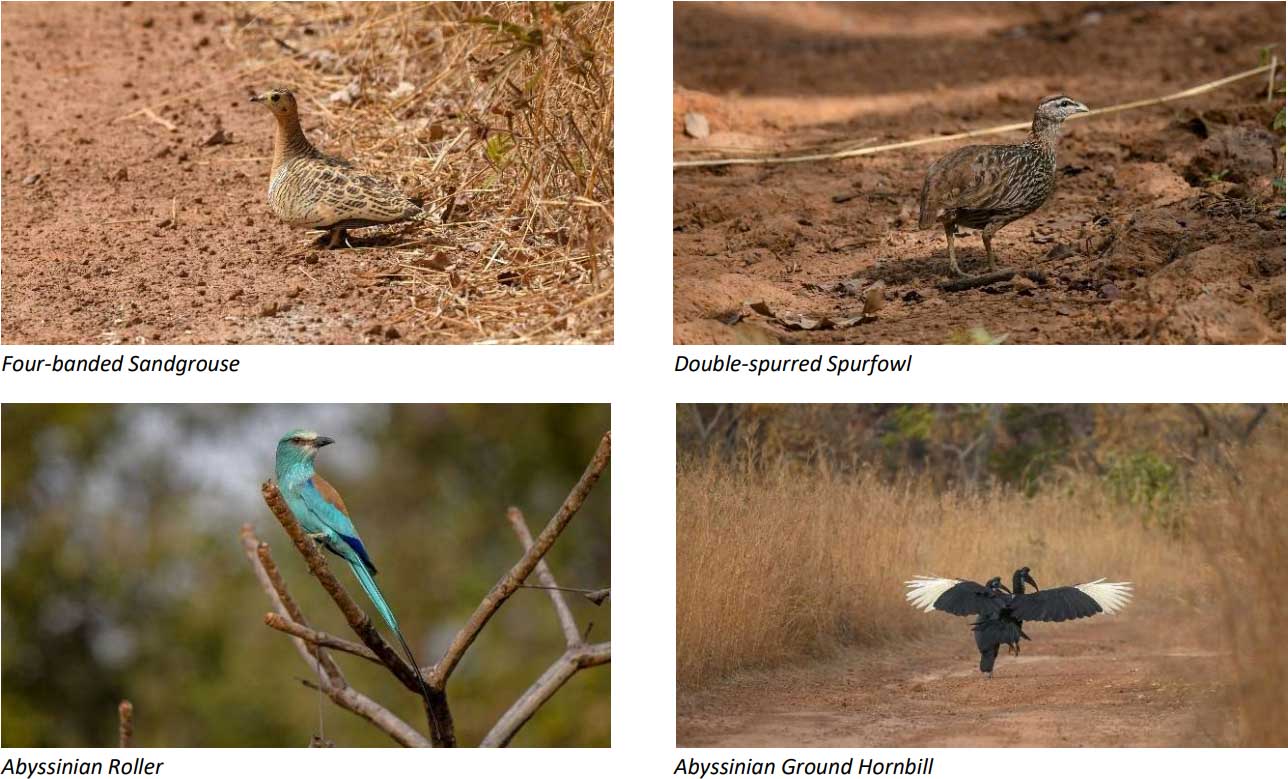

At the remote Camp du Lion we see the following new species for our trip: Bar-breasted Firefinch, Grey-headed Bushshrike and White-crowned Lapwing. We go back slowly and reach the exit of the national park at 6 p.m., right on time. It was a good day but we actually had hoped to have more activity in the park. I was eager to see White-throated Francolin but that’s nature.
December 12, 2021 - 3rd Advent - Drive to Janjanbureh
Today we go back to The Gambia. In the meantime, we are a well-established team, after breakfast we are on the road at 8 a.m. On the way we again see some birds of prey: Tawny Eagle and Beaudouin's Snake Eagle and another eagle that leads to controversial discussions. In the end we agree on Ayres's Hawk-Eagle (white morph) - I had advocated for Wahlberg's Eagle. Otherwise, the ride is unspectacular. There are no problems at the border at 12 o'clock either.

We drive to Bansang via Basse Santa Su and stop at the quarry. In the meantime, it is very hot, so that only a few Red-throated Bee-eaters fly around. However, we see an Exclamatory Paradise Whydah (lifer)! We decide to go on to Janjanbureh without a lunch break to catch up on the boat trip that was actually scheduled for December 9th. Our accommodation is the Baobolong Camp, where we take a short walk in the garden and promptly spot African Golden Oriole and White-crowned Robin-Chat, both of which are lifers for me. How fortunate!

Our two-hour cruise on the Gambia River takes us into a tributary where we see hippos, Guinea Baboons and Western Red Colobus Monkey and lots of birds like Western Red-billed Hornbill, African Darter, Black-crowned Night Heron, Long-crested Eagle, Palm-nut Vulture, and European Turtle Dove.
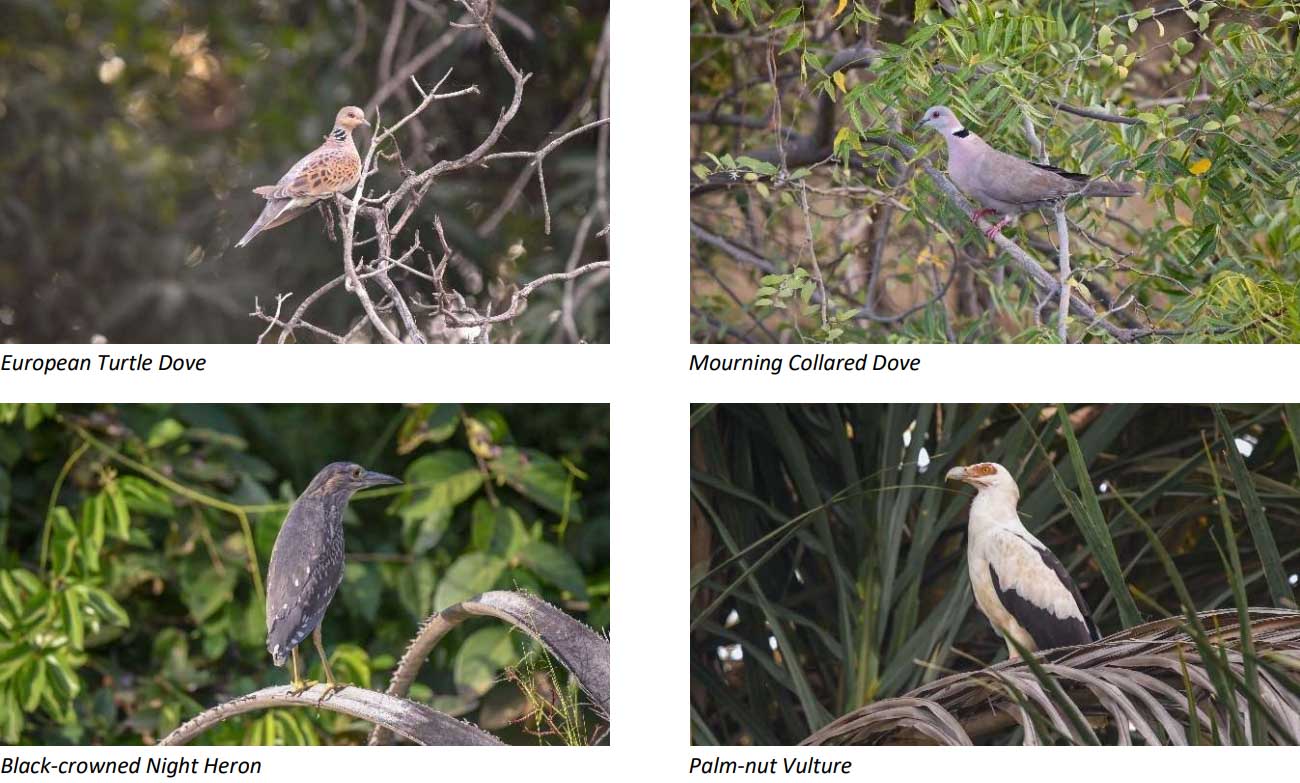
December 13, 2021 - Drive to Tendaba Camp
We have a relatively short drive ahead of us, giving us plenty of time for stops along the way. Just behind Janjanbureh we walk through the bushland for an hour and see many typical birds such as Shikra, Scarlet-chested Sunbird, Pygmy Sunbird, Northern Crombec, Senegal Batis and Sahel Bush Sparrow. New to the trip is the Brown-backed Woodpecker. The next destination is near Brikama Ba, where I can see the typical stages of rice cultivation at the Sapu rice fields. There are an incredible number of African Jacanas. At the ditches we discover a Eurasian Reed Warbler. Unfortunately, the desired Black Coucal can neither be heard nor seen.
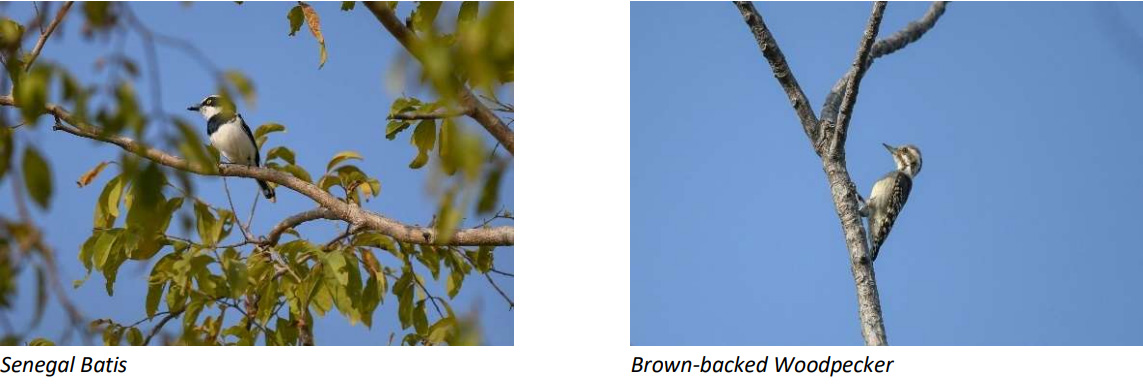
At Dalaba we stop at a body of water covered with water lilies. In addition to our target bird - the African Pygmy Duck - we can also see Spur-winged Lapwing, White-faced Whistling Duck, Northern Pintail, Garganey and Knob-billed Duck. After spotting three Abyssinian Ground Hornbill, we scan a shallow water area just before Soma and find Gull-billed Tern, West African Swallow, Hamerkop, Marsh Sandpiper, Pink-backed Pelican and African Silverbill (lifer).
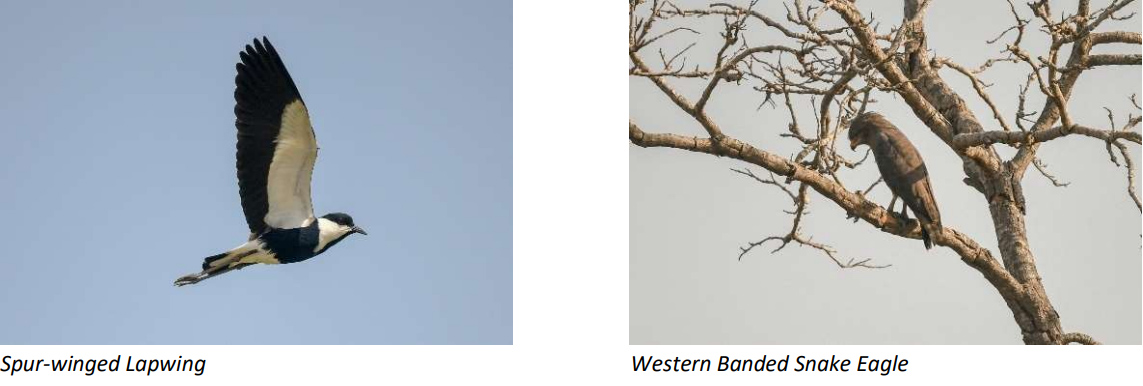
Shortly before getting to Tendaba, we see a beautiful Western Banded Snake Eagle. After arrival at 4:30 p.m. we settle into our rooms and then set off on foot to the bird watching hide above the village. Karanta tells me that the terrain here is taboo, so no houses are built, although the topography is much more suitable than the steep slope to the river. Unfortunately, there are only a few birds there, so we make a detour by car to a Brazil nut plantation. But the Bronze-winged Courser we are looking for is unfortunately not there.
December 14, 2021 - Tendaba
We stay the whole day near Tendaba Camp, which is located directly on the river Gambia. It is a large lodge, originally a hunting camp founded by a Swede, today the destination of many bird watchers and also the meeting place of Gambian authorities. Today there are more officials than foreign tourists on site.
At the beginning we scan a wetland near the river and see Pink-backed Pelican, Grey Plover, Common Sandpiper, Common Greenshank, Slender-billed Gull, Gull-billed, Caspian, Lesser Crested and Sandwich Tern. A good start in the morning. We then drive to Kwinella on the South Bank Road and turn onto a dirt track where we spend the morning observing on foot. We mainly use the dirt road, but Karanta keeps leading me into the middle of the bush. It's nice to have a lot of time in the field. A Yellow-bellied Hyliota (lifer) is the highlight for me! We also see Four-banded Sandgrouse, Namaqua Dove, Grasshopper Buzzard, Mottled Spinetail, Pallid Swift, Black Scimitarbill, Fine-spotted Woodpecker, Brown-necked Parrot, Common House Martin, White-shouldered Black Tit, Greybacked Camaroptera, Striped Kingfisher, flocks of White-crested Helmetshrike, a skulking Redshouldered Cuckooshrike, Northern Puffback, Common Redstart, Red-winged Warbler, Tree Pipit, and Pin-tailed Whydah.
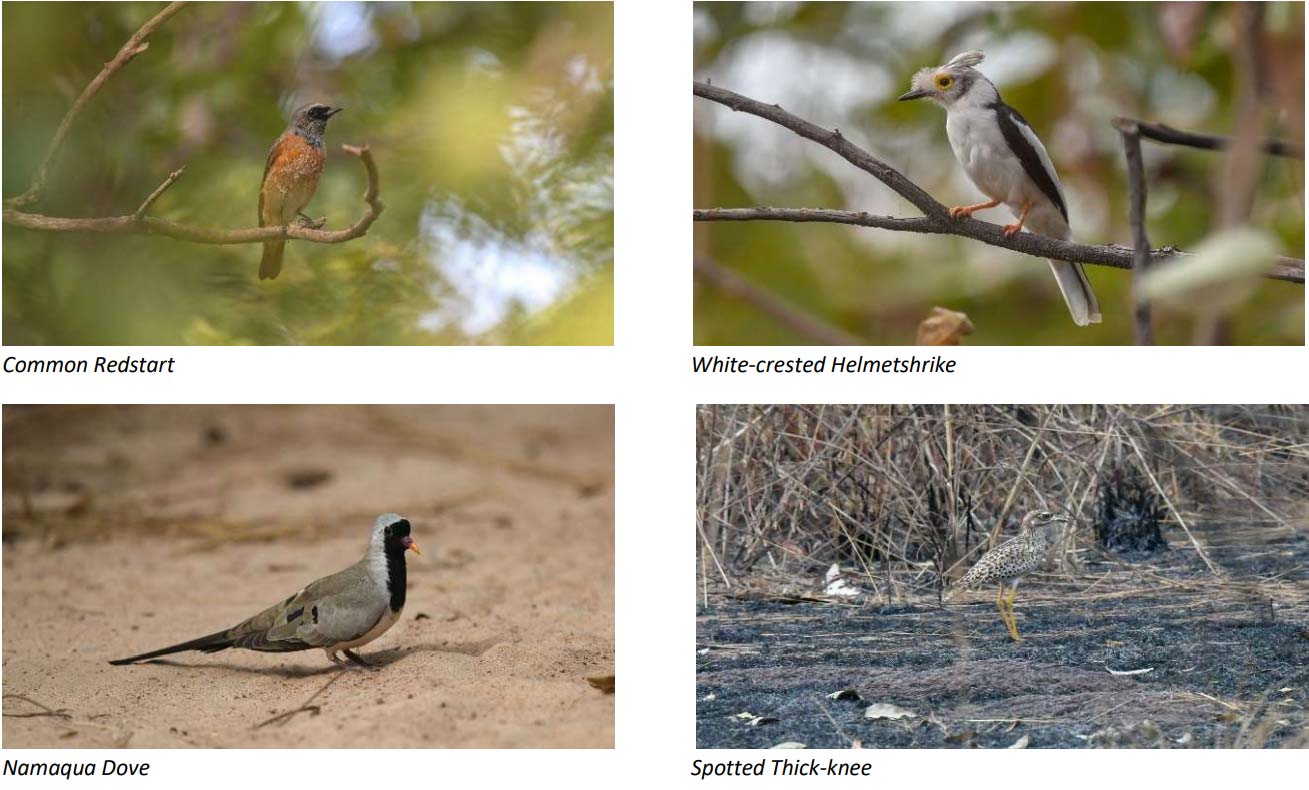
At noon we reach Kiang West National Park – it covers an area of 190 km². Since it is now very hot, we only see a few European Bee-eaters. Along the dirt road to Batelling we are thrilled to find one of the main targets of the day: Yellow Penduline Tit (lifer). While we scramble to take pictures, a distant Black Stork soars in the sky, a first sighting in Africa for me.
During lunch break in Tendaba I can study the two species of kite: Yellow-billed Kite and Black Kite. After locating a Spotted Thick-knee in the afternoon, we again look intensively in the fields for the Bronze-winged Courser, which is active in the twilight - unfortunately it shouldn't be.
A very eventful day comes to an end with the buffet in the open dining room of Tendaba Camp. There's fish, beef, veggies and potatoes, plus two cans of Cody's - a German beer I actually don't know. My bird list is filling up: today we had 122 species, 12 of which were new for our trip. This brings us to a total of 287 species, of which 48 are lifers for me. This is really great and more than expected. In the remaining four days we should get to 300!
December 15, 2021 - Bao Bolong and drive to Sita Joyeh
Another highlight is coming up: our last boat trip! At 8:30 a.m. we start, across the river Gambia into the mangrove forests on the other side. There is a British couple who also want to see the wildlife without focusing on the birds like we do. But that doesn't matter at all - we are all excited about the abundance of animals. At 220 km², the Bao Bolong Wetland Reserve is the largest protected area in The Gambia and a RAMSAR site of international importance.

Right at the beginning we see Mouse-brown Sunbird (lifer), which, however, cannot be photographed. On an unwooded area we see dozens of Great White Pelicans, an African Spoonbill, some Yellow-billed Storks, Pink-backed Pelicans, Montagu's Harrier, Blue-cheeked Bee-eaters, Whimbrel and also a Patas Monkey. Unfortunately, the African Finfoot is again not to be seen, but Karanta discovers a White-backed Night Heron, which I have only been able to see at Lake Mburo in Uganda. Then we pass a breeding colony of White-breasted Cormorant. The scarce White-crested Tiger Heron doesn't show up, but that wasn't to be expected either. But we are able to add African Blue Flycatcher, White-throated Bee-eater and Goliath Heron to our trip list.
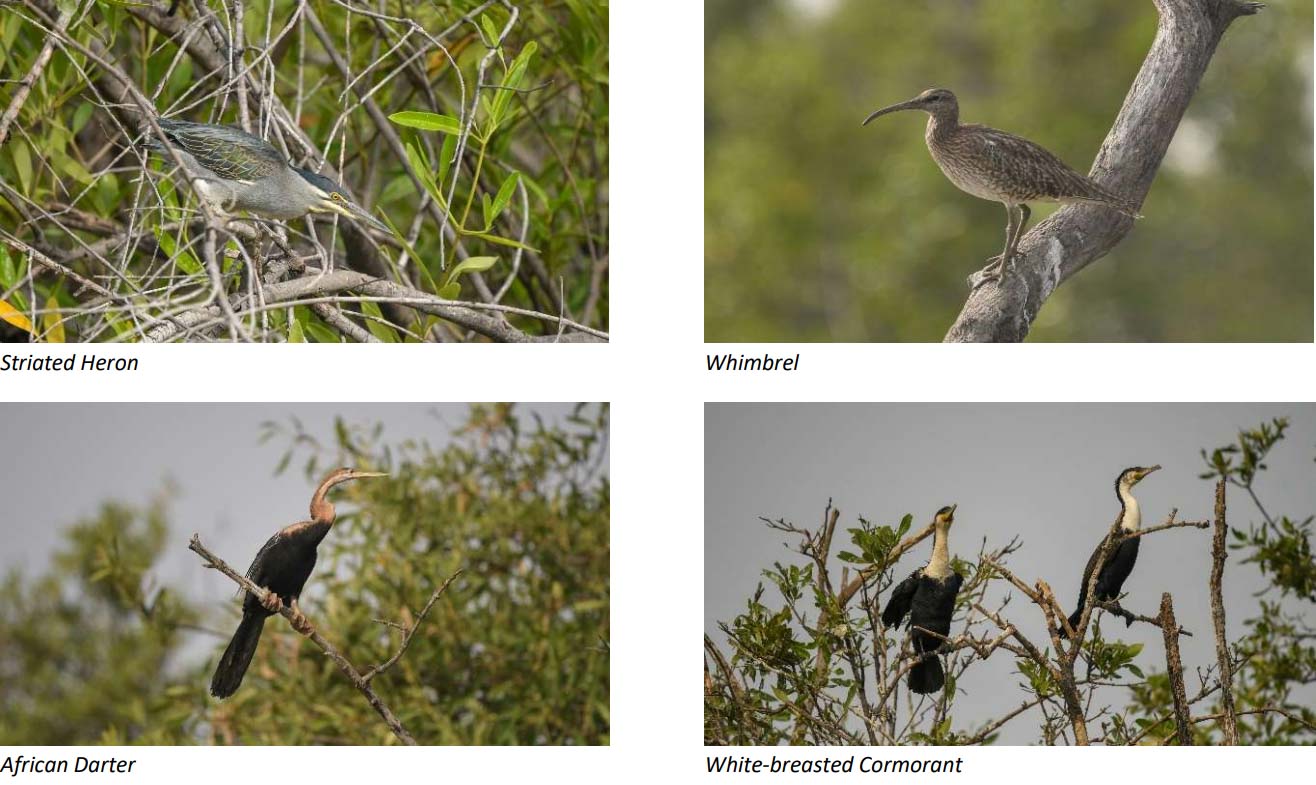
As on the outward journey, we make a longer stop in Kampant at the "Raptors' Cottage" where we see Hooded, Rüppell's and Griffon Vulture, Wahlberg’s Eagle, Black-winged Kite, several African Harrier-Hawks, and also two Lanner Falcons. Even though we are happy to see a pair of Blue-bellied Rollers, Grey-headed Kingfisher and Brown Babbler, it is rather quiet on the small river at noon. Nevertheless, we find a Violet Turaco, which I can digiscope quite well.

Our accommodation for the last three nights is Sita Joyeh Baobab Island Resort in the middle of a small island near the river Gambia. We arrive at the island around 5 p.m. We are brought to the island by canoe - there is no bridge. The facility has an eventful history, as I learn: for several years, drug dealers did their business here and smuggled cocaine from South America to Europe. Now it's a budget hotel: great location, structurally sound buildings, but still quite run down. I get one of the large bungalows and can choose my bed. We are the only guests. Before dinner we explore the island: there are numerous Senegal Parrots and Rose-ringed Parakeets as well as a Red-chested Swallow that builds a nest in my entrance area. In the evening we hear an African Scops Owl.
December 16, 2021 - Photo Hideout near Baobab Island, Penyem and Marakissa
We're back in the coastal region and have three more days to fill the list and discover new things. We are at 296 species and 49 lifers - of course we still want to reach 300 and 50. There are still a number of chances.
So, we set off anxiously, but have to realize that there is a large oil stain under the bus. The dipstick indicates that there is no oil in the engine. Of course, we can't leave like this. We improvise: Aziz rides a borrowed bike to the main street to get oil, while Karanta and I go to the nearby photo hide to pass the time there. And it's worth it: we see a lot of birds, including the Green-headed Sunbird, which I can photograph very nicely at the watering trough. The Spotted Honeyguide is also wonderful to see, as well as many doves and pigeons and other rather common birds like Common Bulbul, African Thrush, African Grey Woodpecker, Northern Red Bishop, Lavender Waxbill, Red-billed Firefinch, and Red-cheeked Cordon-bleu. After two and a half hours, Aziz comes with the bus and we can leave for our originally-planned destination.
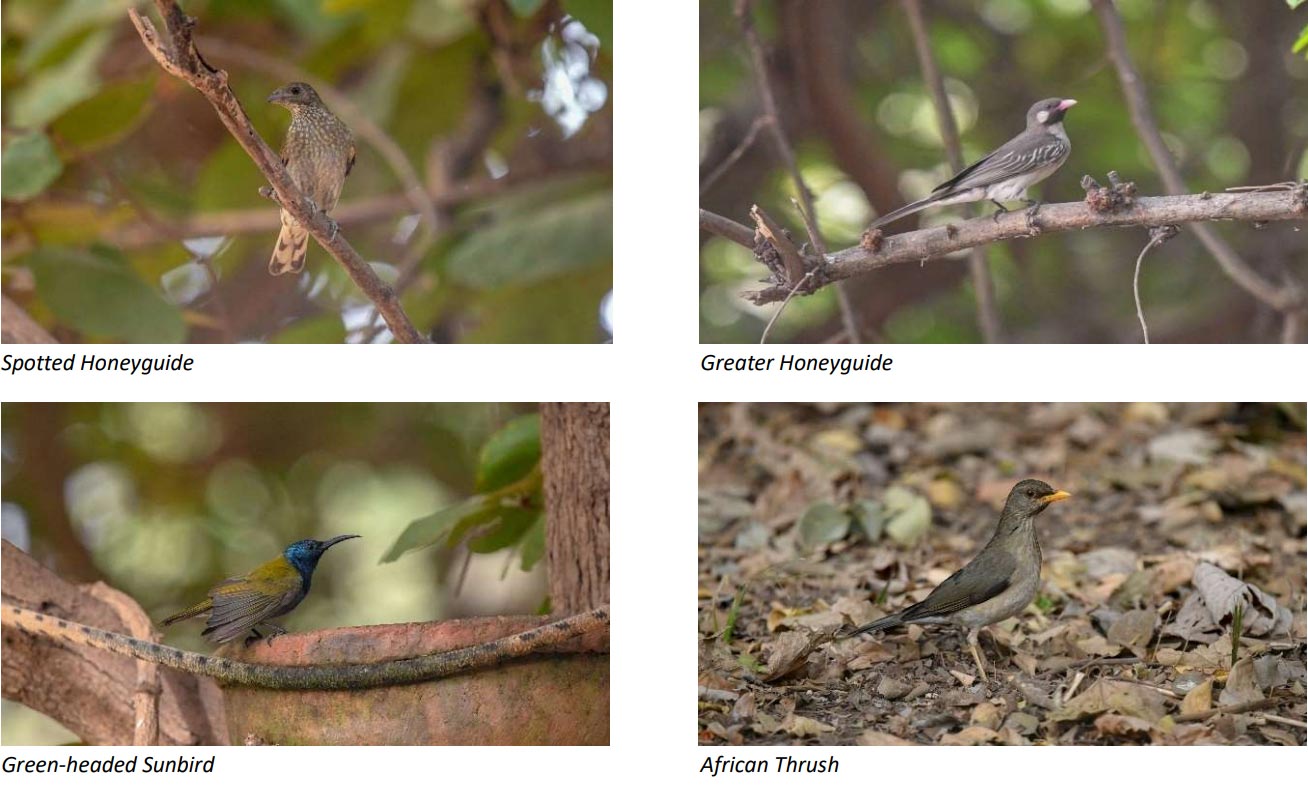

On the way towards the coast we stop in Brikama for some shopping. Then it's on to Penyem where we search the fields and bushland intensively to find the White-breasted Cuckooshrike, our target for the day. Karanta has seen it here several times. We walk through the site for two hours - without success. But Karanta discovers a Northern White-faced Owl in an acacia tree (Lifer!).
We eat our lunch right next to the street: Baguette with tuna and canned chicken, with fresh watermelon. In the afternoon we visit the idyllic Marakissa River Camp, run by a Dutchman, very close to the border with Senegal. It is not much going on but we are able to get good looks of a Giant Kingfisher.
December 17, 2021 - Brufut and Tanji Reserve
Today is our last full day. It begins with a good breakfast at 8 a.m. - there's bread, fried eggs and pancakes. We want to spend a lot of time in a hide that has been set up in the Brufut Woods Bird Sanctuary. It was initiated by local bird guides and offers the opportunity to see some of the bushland's rarer birds. Similar to Gunjur, the forest of only 1 km² is owned by the municipality and is mainly used for gathering fruits. We spend a total of 4 hours there and with patience and perseverance we can see almost all the species we were hoping for, including the two lifers Guinea Turaco and Fanti Saw-wing, a West African endemic. The observatory is a small clearing with two water troughs in the trees and one on the ground. The birds are used to the "service", especially doves – we see Red-eyed, Vinaceous, and Laughing Dove as well as Black-billed and Blue-spotted Wood Dove. Also, many smaller birds also make an appearance, such as African Pygmy Kingfisher, Little Bee-eater, Greater Honeyguide, Black-necked Weaver, Red-bellied Paradise Flycatcher, Yellowthroated Leaflove, Western Olivaceous Warbler, Blackcap Babbler, Snowy-crowned Robin-Chat, Bronze Mannikin, and Orange-cheeked Waxbill.
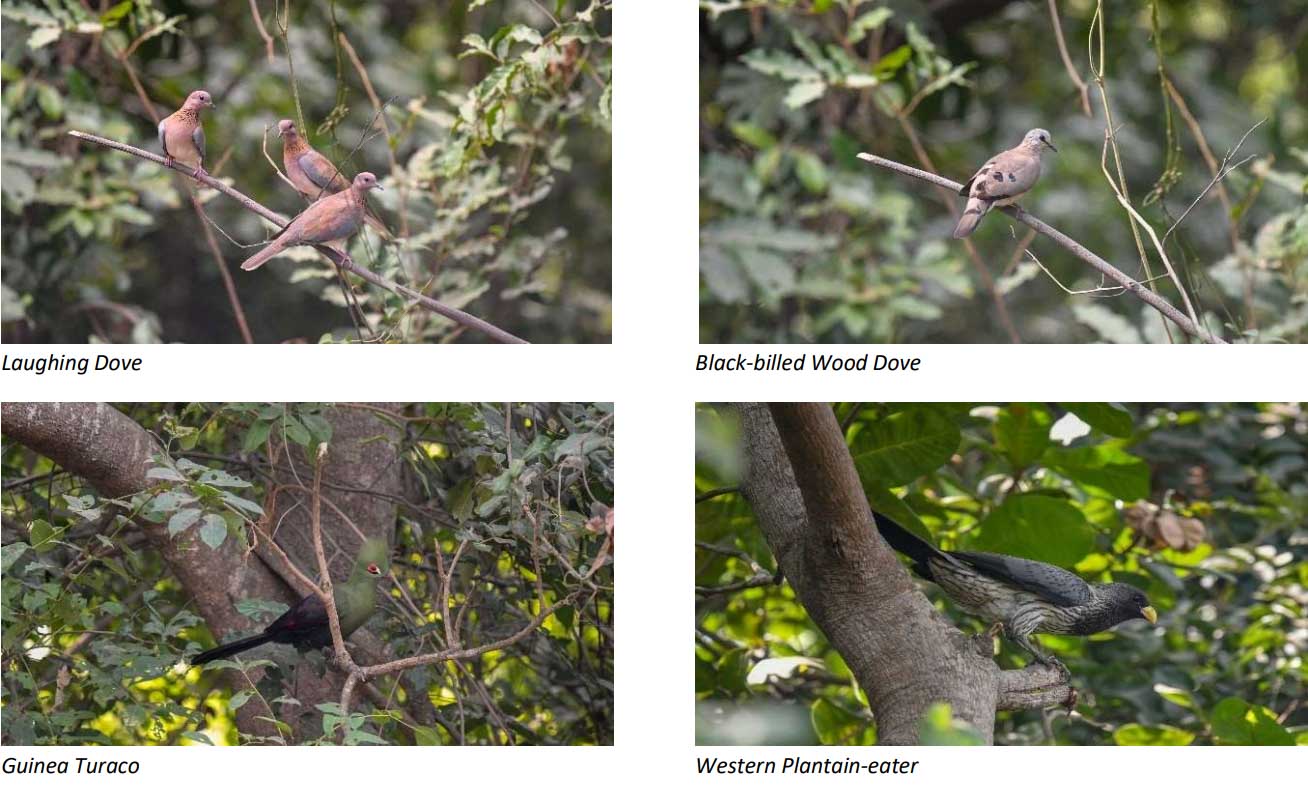
The star of the day is a Guinea Turaco. After three hours of waiting the bird finally shows up and stays for 10 minutes. We also stroll through the forest and are excited to see Orange-breasted Bushshrike, Diederik Cuckoo, and Klaas's Cuckoo, all three at the same spot. The local guide shows me a Long-tailed Nightjar close to the trail, which is almost invisible on the ground.

In the afternoon we drive again to the Tanji Bird Reserve right on the coast to track down the Western Bluebill. Tanji Bird Reserve Eco-Tourism Camp also has a bird bath with benches where we see Little Greenbul. The bluebill doesn't show up at the hide, but Aziz spots the bird on the exit! Another Lifer!

We make one last stop in the dunes and see several Ospreys. And then a Common Nightingale actually sings in a bush, the bird is probably practicing here in the winter quarters for spring in Europe... A fantastic and special end to this day!
December 18, 2021 - Abuko Nature Reserve and Kotu Bridge
We saved the most important nature reserve in the coastal region for the last day: the Abuko Nature Reserve, which is only 1 km² in size. The area was placed under protection as early as 1968. It includes a last remnant of original gallery forest along the small river Lamin, the northernmost foothills of the tropical vegetation zone Upper Guinea Forest, which stretches from Togo to Gambia and is characterized by a high level of biodiversity. Abuko is home to over 50 species of mammals and over 270 species of birds. The birds are used to people, so some nice observations can be made.

Right at the beginning we spot a Black Sparrowhawk that I had only seen in Semliki, Uganda, so far. Another new species for the journey is the Yellow-breasted Apalis. We also see Violet Turaco, Western Plantain-eater, Palm-nut Vulture, African Pied Hornbill, Grey-headed Bristlebill, Senegal Batis and a Brown-throated Wattle-eye. Then it's midday, and with that activity is declining.
We drive to Tabokoto to the Kaira Restaurant run by a neighbour from Karanta’s home village.
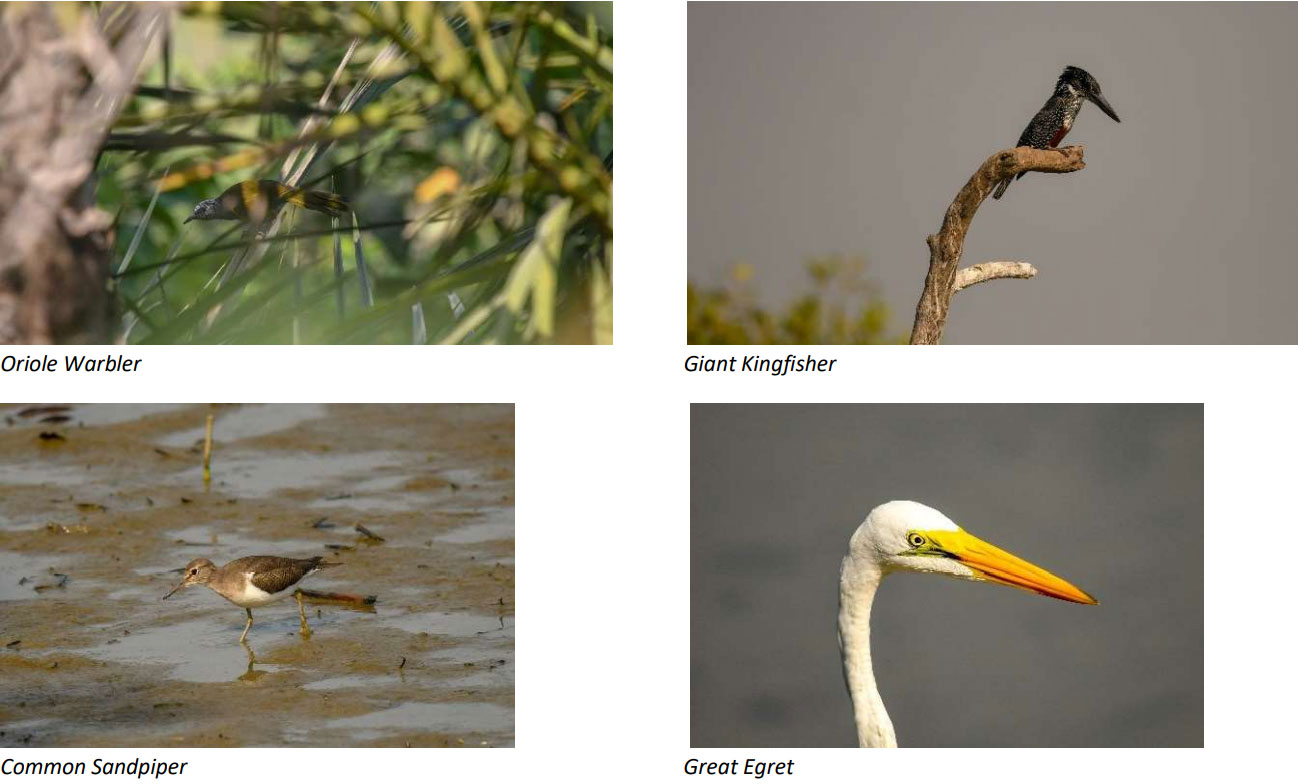
After lunch we have two hours left before we need to go to the airport. We drive to Kotu Bridge, the headquarters of the bird guides. The Oriole Warbler is still missing. And: it is there and I can even take a decent picture of it. This makes the 54th lifer on the list. Excellent! - I was counting on 40+. What perseverance can do...

Another journey is over. What will "stick"? First of all, joy about the experience and gratitude for the smooth success. After almost two years of Corona, a lot is no longer the way it used to be. Empty lodges and unemployed guides show that the consequences of the epidemic hit the poorest particularly hard, while our life in Europe goes on with relatively few restrictions. During the trip, I didn't notice the Corona pandemic at all. The much younger population in Gambia and Senegal is probably better able to cope with the virus than our affluent society with various "civilization diseases".
It was great to be back in Africa, to travel to two new countries. Karanta has proven to be a very good guide. His decision to take Aziz with him as a driver was also very beneficial. This allowed Karanta to focus entirely on observing. A total of 311 bird species are on my list, including 54 lifers and 10 first sightings in Africa. We also saw 15 mammal species. I'm very happy with that. I will definitely come back, because some species can still be found! I'm grateful to have stayed healthy and not been exposed to any danger. Upon arrival in Hamburg, I happily hug my family and my neighbours. Christmas can come.
To book your tour knock Karanta Camara.
Birds (IOC Word Bird List)
Blue-bellied Roller
Broad-billed Roller
Grey-headed Kingfisher
Striped Kingfisher
Blue-breasted Kingfisher
Woodland Kingfisher
African Pygmy Kingfisher
Malachite Kingfisher
Giant Kingfisher
Pied Kingfisher
Swallow-tailed Bee-eater
Little Bee-eater
Red-throated Bee-eater
White-throated Bee-eater
Green Bee-eater
Blue-cheeked Bee-eater
European Bee-eater
Northern Carmine Bee-eater
Yellow-fronted Tinkerbird
Vieillot's Barbet
Bearded Barbet
Spotted Honeyguide
Greater Honeyguide
Eurasian Wryneck
Fine-spotted Woodpecker
Cardinal Woodpecker
African Grey Woodpecker
Brown-backed Woodpecker
Lesser Kestrel
Common Kestrel
Grey Kestrel
Red-necked Falcon
Lanner Falcon
Brown-necked Parrot
Senegal Parrot
Rose-ringed Parakeet
Senegal Batis
Brown-throated Wattle-eye
Grey-headed Bushshrike
Orange-breasted Bushshrike
Black-crowned Tchagra
Northern Puffback
Yellow-crowned Gonolek
Brubru
White-crested Helmetshrike
Red-shouldered Cuckooshrike
Yellow-billed Shrike
Woodchat Shrike
African Golden Oriole
Glossy-backed Drongo
Red-bellied Paradise Flycatcher
Splendid Sunbird
Variable Sunbird
Red-chested Swallow
Wire-tailed Swallow
Common House Martin
Mosque Swallow
West African Swallow
Northern Crombec
Green Hylia
Western Bonelli's Warbler
Common Chiffchaff
Eurasian Reed Warbler
Western Olivaceous Warbler
Melodious Warbler
Singing Cisticola
Whistling Cisticola
Zitting Cisticola
Tawny-flanked Prinia
Red-winged Prinia (Warbler)
Yellow-breasted Apalis
Oriole Warbler
Grey-backed Camaroptera
Yellow-bellied Eremomela
Senegal Eremomela
Subalpine Warbler
Common Whitethroat
Northern Yellow White-eye
Capuchin Babbler
Brown Babbler
Blackcap Babbler
Yellow-bellied Hyliota
Greater Blue-eared Starling
Lesser Blue-eared Starling
Bronze-tailed Starling
Purple Starling
Long-tailed Glossy Starling
Chestnut-bellied Starling
Yellow-billed Oxpecker
African Thrush
Rufous-tailed Scrub Robin
Northern Black Flycatcher
Swamp Flycatcher
Snowy-crowned Robin-Chat
White-crowned Robin-Chat
Common Nightingale
Common Redstart
Northern Anteater Chat
Northern Wheatear
White-fronted Black Chat
Mouse-brown Sunbird
Pygmy Sunbird
Green-headed Sunbird
Scarlet-chested Sunbird
Chestnut-backed Sparrow-Lark
Flappet Lark
Crested Lark
Grey-headed Bristlebill
Yellow-throated Leaflove
Little Greenbul
Common Bulbul
Fanti Saw-wing
House Sparrow
Northern Grey-headed Sparrow
Sudan Golden Sparrow
Sahel Bush Sparrow
White-billed Buffalo Weaver
Chestnut-crowned Sparrow-Weaver
Speckle-fronted Weaver
Little Weaver
Black-necked Weaver
Village Weaver
Red-billed Quelea
Northern Red Bishop
Bronze Mannikin
African Silverbill
Lavender Waxbill
Orange-cheeked Waxbill
Black-rumped Waxbill
Quailfinch
Cut-throat Finch
Red-cheeked Cordon-bleu
Western Bluebill
Red-billed Firefinch
Bar-breasted Firefinch
Black-faced Firefinch
Village Indigobird
Pin-tailed Whydah
Sahel Paradise Whydah
Exclamatory Paradise Whydah
Western Yellow Wagtail
White Wagtail
Tawny Pipit
Tree Pipit
White-rumped Seedeater
Yellow-fronted Canary
Gosling's Bunting
African Paradise Flycatcher
Piapiac
Pied Crow
African Blue Flycatcher
White-shouldered Black Tit
Beautiful Sunbird
Mammals
uinea Baboon
Common Patas Monkey
Western Red Colobus
Gambian Sun Squirrel
Striped Ground Squirrel
Side-striped Jackal
Banded Mongoose
Marsh Mongoose
Oribi
Roan Antelope
Harnessed Bushbuck
Common Warthog
Hippopotamus
Gambian Epauletted Fruit Bat
Read aslo-
Gambia Tour Report Jan, 2022
Gambia Tour Report Nov, 2022
Gambia Tour Report Jan, 2023